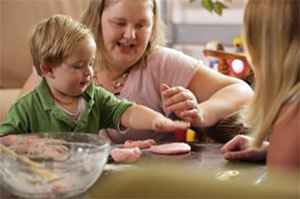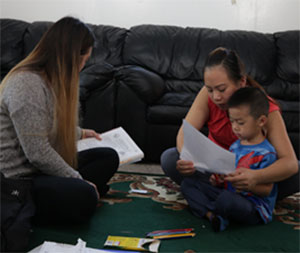This section describes the HSPPS that provide the general requirements of the home-based option.

Home-based option, 45 CFR §1302.22
(b) Caseload
A program that implements a home-based option must maintain an average caseload of 10 to 12 families per home visitor.
(c) Service Duration
Early Head Start home-based programs must:
- Provide one home visit per week per family that lasts at least an hour and a half and provide a minimum of 46 visits per year
- Provide, at a minimum, 22 group socialization activities distributed over the course of the program year
Head Start programs must:
- Provide one home visit per week per family that lasts at least an hour and a half and provides a minimum of 32 visits per year
- Provide, at a minimum, 16 group socialization activities distributed over the course of the program year
(c)(3) Meeting Minimum Requirements
A program that implements a home-based option must:
- Make up planned home visits or scheduled group socialization activities that were canceled by the program, and to the extent possible, attempt to make up planned home visits canceled by the family when this is necessary to meet the minimum requirement
- Not replace home visits or scheduled group socialization activities for medical or social service appointments for the purposes of meeting the minimum requirements

Education in home-based programs, 45 CFR §1302.35
(a) Purpose
Carried out through home visits and group socializations, activities focus on the promotion of secure parent-child relationships and helping parents take advantage of the learning experiences available to young children throughout their day-to-day routines. Promotion of secure parent-child relationships is covered in Home-Based Service Delivery: A Secure Parent-Child Relationship.
(b) Home-based Program Design
- Planned jointly by the home visitor and parents to reflect the critical role of parents
- Planned using information from ongoing assessments (see Home-Based Service Delivery: Ongoing Assessment and Curriculum Planning)
- Scheduled with enough time to serve all enrolled children
- Conducted with the parents present
- Scheduled with time to provide required comprehensive services

(c) Home Visit Experiences
A program that operates the home-based option must ensure all home visits:
- Focus on high-quality learning experiences
- Focus on growth toward the goals described in the Head Start Early Learning Outcomes Framework: Ages Birth to Five (ELOF)
- Use these goals and the curriculum to plan home visit activities that implement:
- Age and developmentally appropriate, structured child-focused learning experiences
- Strategies and activities that promote parents' ability to support the child's cognitive, social, emotional, language, literacy, and physical development
- Strategies and activities that promote the home as a learning environment that is safe, nurturing, responsive, and language- and communication-rich
- Research-based strategies and activities for children who are dual language learners that recognize bilingualism and biliteracy as strengths
- For infants and toddlers, focus on the development of the home language, while providing experiences that expose both parents and children to English
- For preschoolers, focus on both English language acquisition and the continued development of the home language
- Follow-up with the families to discuss learning experiences provided in the home visit, address concerns, and inform strategies to promote progress toward school readiness goals
(d) Home-based Curriculum
The research-based, home-based curriculum programs use for home visits and socializations must:
- Promote the parent's role as the child's teacher
- Be developmentally appropriate
- Align with the ELOF
- Have an organized developmental scope and sequence
- Support staff in effective implementation
- Provide interactions, learning experiences, and environments that deliver:
- Developmentally, linguistically, and culturally appropriate activities
- Activities that support children's cognitive, social, and emotional growth for later success in school
Group socialization, 45 CFR §1302.35(e), is covered in Group Socializations.
Parent activities to promote child learning and development, 45 CFR §1302.51
Home visitors must also support parents as they pursue education and life skills and comprehensive health services for themselves and their children. This is part of the child and family goals and applies to all program options.
Read more:
Resource Type: Article
National Centers: Early Childhood Development, Teaching and Learning
Last Updated: September 27, 2023